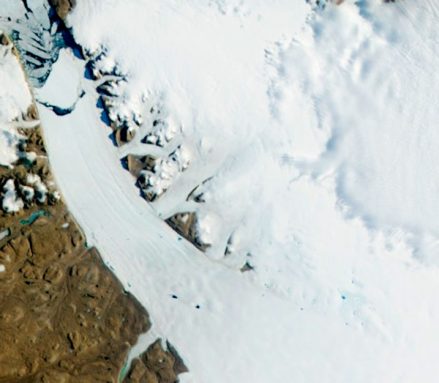Hot summer for a cold island
A rare heat wave rolled over Greenland in July, thawing its ice and snow

A heat wave that struck Greenland in July was probably the biggest temperature surge there in more than 100 years, scientists report. The world’s largest island is mostly covered in ice and snow — except when extreme heat sets in.
At one scientific research station, flags planted in the once-frozen snow fell over. Supply planes couldn’t land on the ice runway because it was melting too.
“It was wet and slushy, which made it really hard to walk around on the ice without falling knee-deep into the snow,” Kaitlin Keegan told Science News. Keegan, a graduate student at Dartmouth College in New Hampshire, visited the research station to study the top layer of ice there.
Satellite images of the island indicate that 97 percent of Greenland’s surface ice melted temporarily this summer. That’s a new record, says Earth scientist Marco Tedesco of the City University of New York. He uses satellite data to study changes in Earth’s climate. He told Science News that this year’s melt on Greenland was greater than in any other year since satellites started observing seasonal changes in the island’s ice.
At several research stations, scientists drilled holes in the ice and removed cores, which are long cylinders of ice. These tubes reveal the history of melts and freezes within a cold area. The top of the ice core shows more recent temperatures, and the bottom can show what happened decades or more ago. Dorthe Dahl-Jensen of the University of Copenhagen in Denmark told Science News that the ice cores reveal that a similar melt has happened before — in 1889.
“So it is rare indeed,” she told Science News.
At higher altitudes, the melted snow and ice will refreeze when the temperature drops again. But in lowlands near the coast, the meltwater can flow into the ocean and contribute to the rise of sea level.
Ice cores show that in the past, melts like this year’s happened less than once every 100 years. But researchers worry that with global warming, such massive melts may occur more frequently.
“Nature could have caused this [year’s] melt event by chance,” Richard Alley, a glaciologist at Penn State University in University Park, told Science News. “But humans made it more likely with greenhouse gases.”
People burn fossil fuels like oil and coal to produce energy to power everything from computers to cars. This burning releases carbon dioxide and other greenhouse gases, which stay in the atmosphere for years to centuries. These gases trap heat, and that heat can increase the temperature at or near Earth’s surface. Higher temperatures can promote even more melting.
However, predicting the behavior of Greenland’s ice is no easy matter. Satellite data show that ice and snow melting patterns aren’t consistent; they change from year to year. Still, scientists worry that a warmer world will lead to a greener Greenland.
Power Words
fossil fuel A natural fuel such as coal or gas formed in the geological past from the remains of organisms.
glaciologist A scientist who studies glaciers.
core A cylindrical sample of rock, ice or other material obtained by boring with a hollow drill.
satellite A body placed in orbit around Earth or the moon or another planet in order to collect information or for communication, or a naturally-occurring object that orbits another object.
greenhouse gas A gas that traps heat in the atmosphere.







